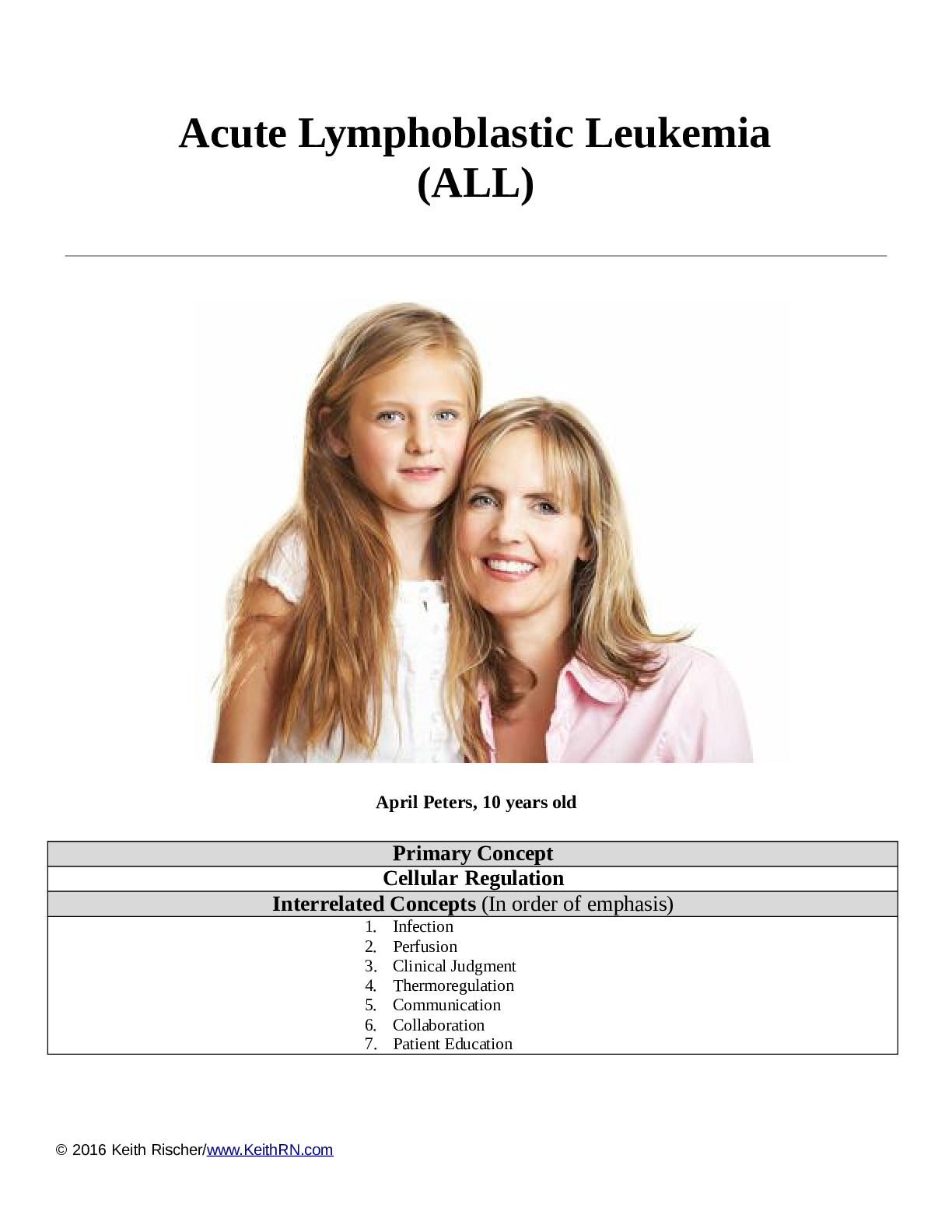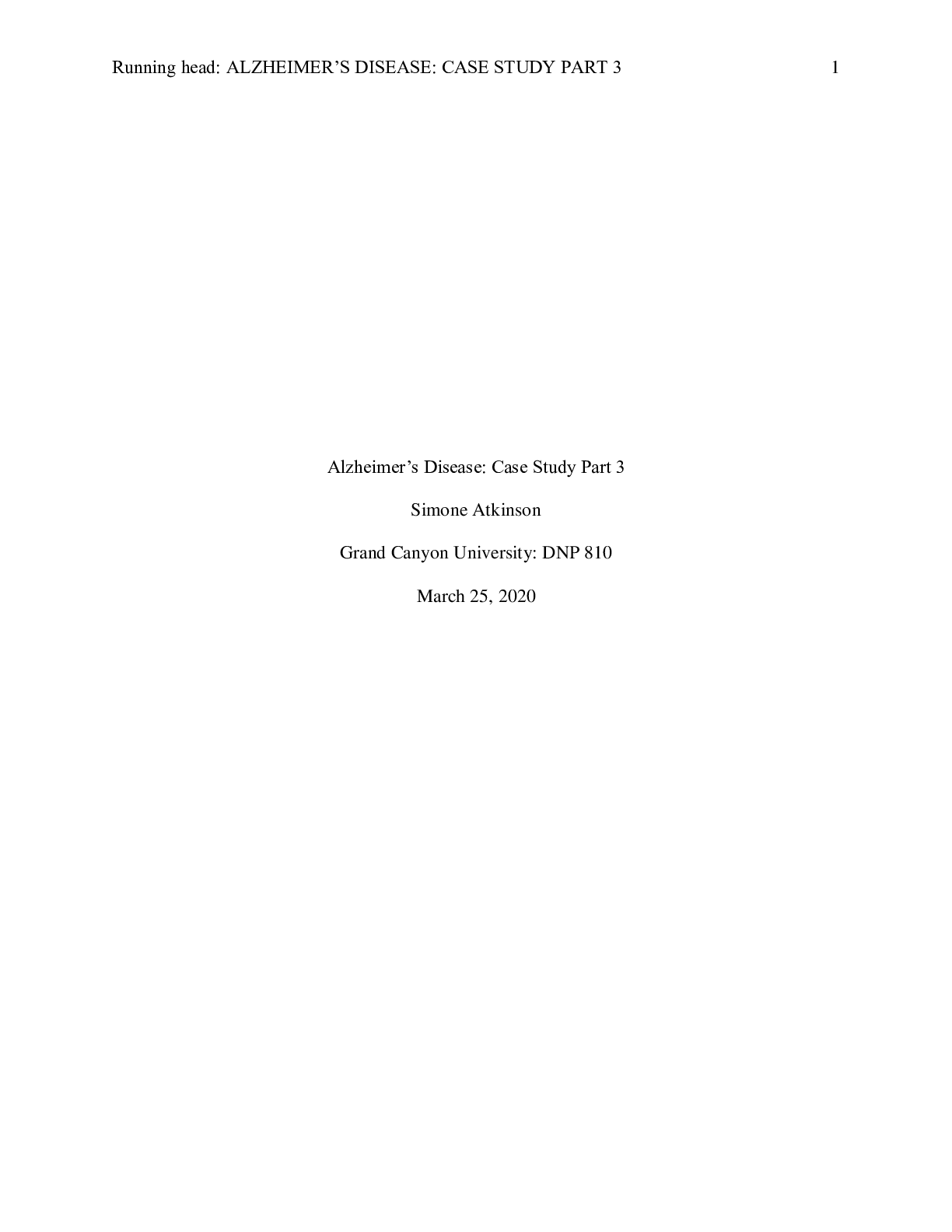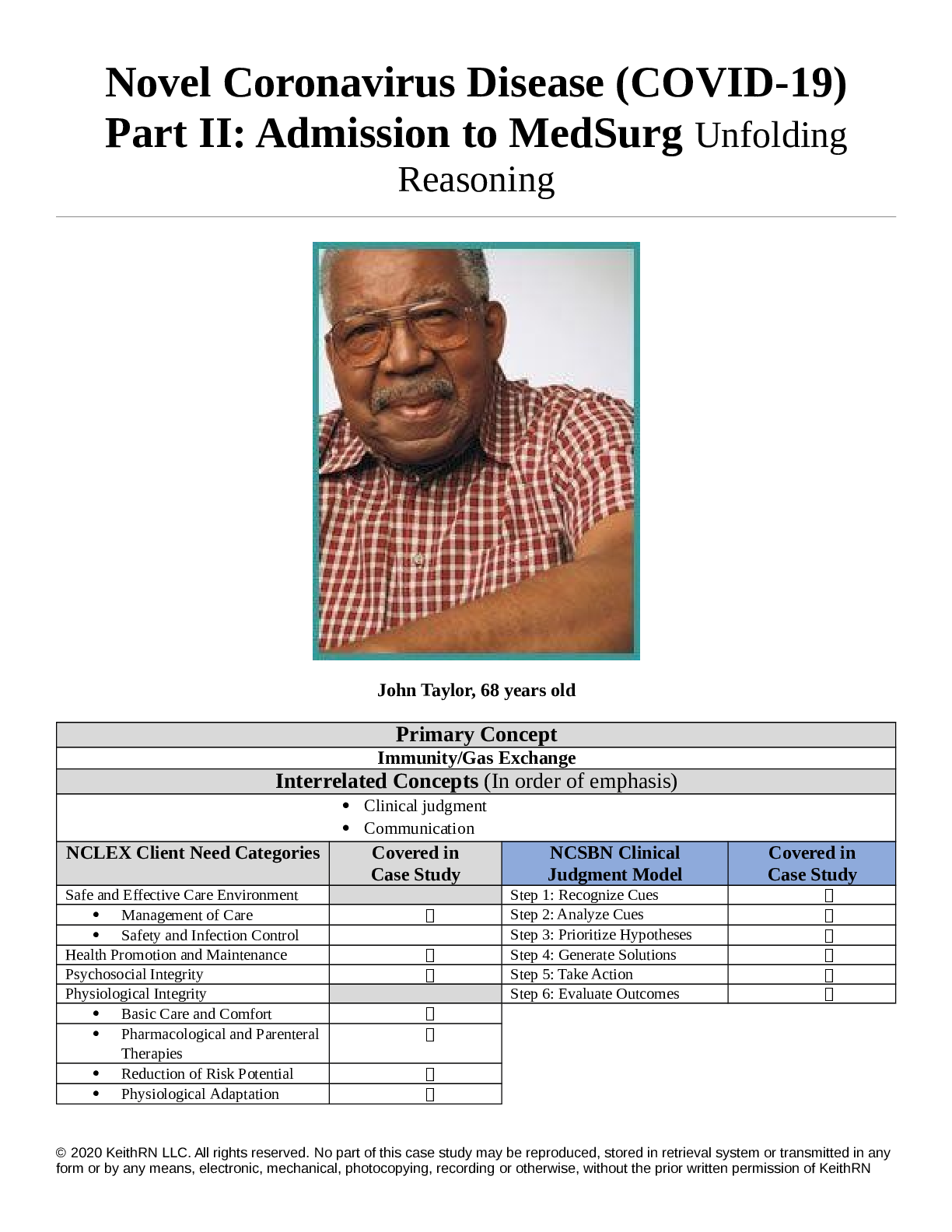*NURSING > CASE STUDY > Acute Lymphoblastic Leukemia (ALL) April Peters, 10 years old / Keiser University - NURSING NUR1211C (All)
Acute Lymphoblastic Leukemia (ALL) April Peters, 10 years old / Keiser University - NURSING NUR1211C keith RN ALL.
Document Content and Description Below
UNFOLDING Reasoning: STUDENT Acute Lymphoblastic Leukemia History of Present Problem: April Peters is a 10-year-old female with acute lymphoblastic leukemia (ALL) who presents to the emergency depa... rtment with a temperature of 38.4 degrees C. (101.2 F.) and a complaint of a sore throat. She has been receiving chemotherapy since her diagnosis three months ago. April’s mother reports that her fever has been unresponsive to acetaminophen and she is two days out from her most recent chemotherapy treatment. No reports of nausea, vomiting, or diarrhea noted. A CBC is drawn immediately from April’s central venous access device (CVAD) and April is admitted directly to the pediatric oncology unit where you are the nurse responsible for her care. She weighs 57 lbs. (25.9 kg), is 51.5 inches (128.8 cm.) and has NKDA. Personal/Social History: April lives at home with her mother Cindy, her father Tom, and her 6-year-old sister Maggie. Tom works full-time as an engineer while Cindy stays home with the children because of April’s diagnosis and resulting hospitalizations and treatment. April has missed quite a few days of school. Although her school system has provided April with a tutor to keep up with her studies, April does not return telephone calls from her friends and refuses their visits. Past Medical History (PMH): Cindy’s pregnancy was uneventful and April was born via an uncomplicated vaginal delivery at 40 weeks and weighed 7 lbs., 1oz. (3.2 kg.) Tonsillectomy at 3 years old under general anesthesia. ALL diagnosis 3 month ago following a short history of headaches and pallor. April’s WBC count at diagnosis was 469,000 FYI: Hyperleukocytosis is defined as a peripheral white blood cell count greater than 100,000/mm3 and is a pediatric oncologic emergency. These white blood cells are immature blast cells not normal cells. Hyperleukocytosis can progress to capillary obstruction, microinfarction, and organ dysfunction, which can lead to respiratory distress and cyanosis. Children may also experience changes in neurologic function, including an altered level of consciousness, visual disturbances, confusion, and ataxia. What data from the histories is RELEVANT and has clinical significance to the nurse? RELEVANT Data from Present Problem: Clinical Significance: Diagnosis with ALL Temperature of 38.4 C or 101.2 F and fever is unresponsive to acetaminophen Sore throat Receiving chemotherapy, starting 3 months ago -It is a disease of malignancies affecting BM and other lymphatic system. Can be fatal -Possible infection and it can be serious due to her chemo treatment and suppressed immune system -Infection and it needs to be treated with antibiotics before it progresses into complication such as rheumatic fevers. -Chemotherapy suppresses immune system RELEVANT Data from Social History: Clinical Significance: Frequent hospitalization and treatments Missing days of school April is withdrawing from her friends and refusing their visits -It causes physical and emotional stress r/t treatments and hospitalization -Missing school can cause emotional distress since she is school age and a sense of accomplishment is gained through school and peer by working together. Feeling of losing control -She is starting to emotionally withdrawn. What is the RELATIONSHIP of your patient’s past medical history (PMH) and current meds? (Which medication treats which condition? Draw lines to connect.) PMH: Home Meds: Mechanism of Action Nursing Considerations 1. Leukemia 2. Chemotherapy 3. Chemotherapy side effects: Constipation Nausea Fever/comfort Sulfamethoxazole- Trimethoprim Ranitidine Docusate Sodium Ondansetron Cyclophosphamide Methotrexate Cytarabine -competitively inhibits dihyropteroate synthase and this inhibitions of pathway prevents the synthesis of tetrahydrofolate and ultimately prevent the synthesis of bacterial purines and DNA, resulting in bacteriostatic effect. -it binds to dihydrofolate reductase and reduction of dihydrofolic acid to tetrahydrofolic acid (THF). This reduction of THF synthesis inhibits bacterial DNA synthesis -It reduces the secretion of gastric acid by reversibly binding to histamine receptors found on gastric parietal cells. -It is an anionic surfactant and lower the surface tension at the oil-water interface of the feces, allowing water and lipids to penetrate the stool and soften the stool. - it is serotonin5-HT3 receptor antagonists and blocks the serotonin action, which results in prevention of nausea and vomiting. - it is an alkylating agent of the nitrogen mustard type 2, It’s activated forms bind to DNA, resulting in cytotoxic effects by disrupting the crosslinking of DNA and RNA and inhibition of protein synthesis. - it is a pyrimidine analog and converted into the triphosphate form from within the cell and competes with cytidine and disrupt the DNA synthesis by hindering the rotation of the DNA molecule. - may cause renal damage, SJ syndrome, N/V, rash, agranulocytosis, aplastic anemia or phlebitis - contraindicated with sulfa allergies - monitor CBC, I&O, - drink plenty of fluid. - same as sulfamethoxazole - administer with meals and at bedtime, assess abdominal pain, monitor for blood in stool, and CBC - discontinue if cramping, rectal bleeding, or N/V occur, administer alone for better absorption - patient should avoid OTC cold medications, assess lung sounds and maintain adequate fluid intake - Instruct patient to report or seek medication for fever or other indications for infection, common side effects are N/V, loss of appetite, stomach pain, diarrhea, hair loss, change in skin color and nails, place patient in protective isolation during hospitalizations - Monitor I&O due to side effects as N/V and loss of appetite and diarrhea, place patient in protective isolation due to their suppressed immune system and instruct the patient to report s/s Acetaminophen - it reduces the prostaglandins production, which is the chemical responsible for inflammation and swelling. of infection - do not exceed 4g per day to reduce the risk of liver, renal and cardiac damage, overdose result in hepatotoxicity. Alter blood glucose measurements and increases the risk for bleeding. Patient Care Begins: Current VS: P-Q-R-S-T Pain Assessment (5th VS): T: 100.8 F/38.2 C (oral) Provoking/Palliative: “My throat hurts” P: 112 (reg) Quality: “Bad” R: 24 (reg) Region/Radiation: Throat BP: 102/66 Severity: “I don’t know.” O2 sat: 96% on room air Timing: Ongoing What VS data are RELEVANT that must be recognized as clinically significant by the nurse? RELEVANT VS Data: Clinical Significance: -Temp 100.8 F -Pulse 112 -Painful throat -Indication of infection -Indication of pain -Indication of pain Current Assessment: GENERAL APPEARANCE: Resting in bed with eyes closed, pale in appearance. RESP: Breath sounds clear with equal aeration bilaterally, nonlabored respiratory effort CARDIAC: Skin is pale, cool to touch. Cap. refill 3-4 seconds in both hands. No edema noted, heart sounds regular with no abnormal beats, radial and pedal pulses present and strong. NEURO: Patient appears lethargic, drowsy, oriented x4 GI: Abdomen soft/nontender, bowel sounds audible per auscultation in all four quadrants. Last BM yesterday evening GU: Voiding without difficulty. SKIN: Skin integrity intact. Central venous access device (CVAD) in place, dressing intact What assessment data is RELEVANT and must be recognized as clinically significant by the nurse? RELEVANT Assessment Data: Clinical Significance: -Lethargic, drowsy -Pale and cool to touch cap refil 3-4 -Due to chemotherapy, patient is experiencing fatigue and lethargy -Possible anemia, due to chemotherapy Lab Results: What lab results are RELEVANT and must be recognized as clinically significant by the nurse? Complete Blood Count (CBC:) Current: High/Low/WNL? Previous: WBC (4.5–11.0 mm 3) 0.2 Low 0.3 Hgb (12–16 g/dL) 7.4 Low 8.2 Platelets (150-450 x103/μl) 54 Low 61 Neutrophil % (42–72) 1 Low 0 Band forms (3–5%) 0 Low 0 What lab results are RELEVANT that must be recognized as clinically significant to the nurse? RELEVANT Lab(s): Clinical Significance: TREND: Improve/Worsening/Stable: WBC 0.2 Hemoglobin 7.4 Platelet 54 Neutrophils 1 Due to chemotherapy, patient is experiencing neutropenia, leukopenia, anemia, and thrombocytopenia. She is at high risk for infection due to her suppressed immune system. Worsening condition Basic Metabolic Panel (BMP:) Current: High/Low/WNL? Previous: Sodium (135–145 mEq/L) 130 Low 129 Potassium (3.5–5.0 mEq/L) 3.5 Low 3.3 Glucose (70–110 mg/dL) 70 WNL 82 BUN (7–25 mg/dl) 26 Slightly high 17 Creatinine (0.6–1.2 mg/dL) 1.4 High 1.1 What lab results are RELEVANT and must be recognized as clinically significant by the nurse? RELEVANT Lab(s): Clinical Significance: TREND: Improve/Worsening/Stable: BUN 26, Creat 1.4 (high) Sodiu m (130 – low) BUN 26 (slightly elevated) Creatinine 1.4 (high) Sodium (130 – low) -Acute lymphocytic leukemia can have effects on kidney function due to increased proliferation of lymphocytes and residing in the kidney, causing tissue necrosis -Due to impaired kidney function and her sore throat she is experiencing electrolyte imbalance Worsening Misc. Labs: Current: High/Low/WNL? Previous: Magnesium (1.6–2.0 mEq/L) 1.9 WNL 2.0 Ionized Calcium (1.05–1.46 mmol/L) 1.05 WNL 1.11 Amylase (25–125 U/l) 29 WNL 31 Lipase (3–73 units/L) 27 WNL 39 Lactate (0.5–2.2 mmol/L) 1.8 WNL 1.7 Coags: PT/INR (0.9–1.1 nmol/L) 0.9 WNL 0.9 What lab results are RELEVANT and must be recognized as clinically significant by the nurse? RELEVANT Lab(s): Clinical Significance: TREND: Improve/Worsening/Stable: Misc. labs (Mg, Ionized calcium, amylase, lipase, lactic acid, PT/INR) Appears to be in WNL Stable Liver Function Test (LFT:) Current: High/Low/WNL? Previous: Albumin (3.5–5.5 g/dL) 3.5 WNL 3.9 Total Bilirubin (0.1–1.0 mg/dL) 1.0 WNL 0.9 Alkaline Phosphatase male: 38–126 U/l female: 70–230 U/l 75 WNL 79 ALT (8–20 U/L) 22 High 20 AST (8–20 U/L) 29 High 21 What lab results are RELEVANT and must be recognized as clinically significant by the nurse? RELEVANT Lab(s): Clinical Significance: TREND: Improve/Worsening/Stable: ALT 22 U/L AST 29 U/L -Increase liver enzyme indicating that liver function is affected by leukemia and chemotherapy Worsening Urine Analysis (UA:) Current: WNL/Abnormal? Color (yellow) Amber Abnormal Clarity (clear) Clear WNL Specific Gravity (1.015-1.030) 1.042 Abnormal Protein (neg) Neg WNL Glucose (neg) Neg WNL Ketones (neg) Neg WNL Bilirubin (neg) Neg WNL Blood (neg) Neg WNL Nitrite (neg) Neg WNL LET (Leukocyte Esterase) (neg) Neg WNL MICRO: RBC’s (<5) 0 WNL WBC’s (<5) 0 WNL Bacteria (neg) Neg WNL Epithelial (neg) Neg WNL What lab results are RELEVANT and must be recognized as clinically significant by the nurse? RELEVANT Lab(s): Clinical Significance: Specific Gravity (1.042) -Impaired kidney function, indicating that kidney has reduced ability to filter out waste substances due to leukemia affecting the kidney. Lab Planning: Creating a Plan of Care with a PRIORITY Lab: Lab: Normal Value: Clinical Significance: Nursing Assessments/Interventions Required: Creatinine Value: 1.4 Critical Value: -Impaired kidney function. -Renal assessment by obtaining BUN and Creatinine value and reconsideration of medications dosages that can harm the kidneys. -Possible renal or peritoneal dialysi [Show More]
Last updated: 2 years ago
Preview 1 out of 16 pages

Buy this document to get the full access instantly
Instant Download Access after purchase
Buy NowInstant download
We Accept:

Reviews( 0 )
$6.00
Can't find what you want? Try our AI powered Search
Document information
Connected school, study & course
About the document
Uploaded On
Jan 28, 2023
Number of pages
16
Written in
Additional information
This document has been written for:
Uploaded
Jan 28, 2023
Downloads
0
Views
123









 April Peters, 10 years old : Keiser University - NURSING NUR1211C keith RN ALL.png)
, April Peters, 10 years old, (Latest 2021) Correct Study Guide, Download to Score A.png)
 SKINNY Reasoning, April Peters, 10 years old, (Latest 2021) Correct Study Guide, Download to Score A.png)


